Well Tested Software

Gleb Bahmutov, PhD
Tuesday, Nov 20, 2018 12:50
🔊 Dr Gleb Bahmutov PhD
C / C++ / C# / Java / CoffeeScript / JavaScript / Node / Angular / Vue / Cycle.js / functional
these slides
14 people. Atlanta, Philly, Boston, LA, Chicago
Fast, easy and reliable testing for anything that runs in a browser
I have Cypress.io stickers
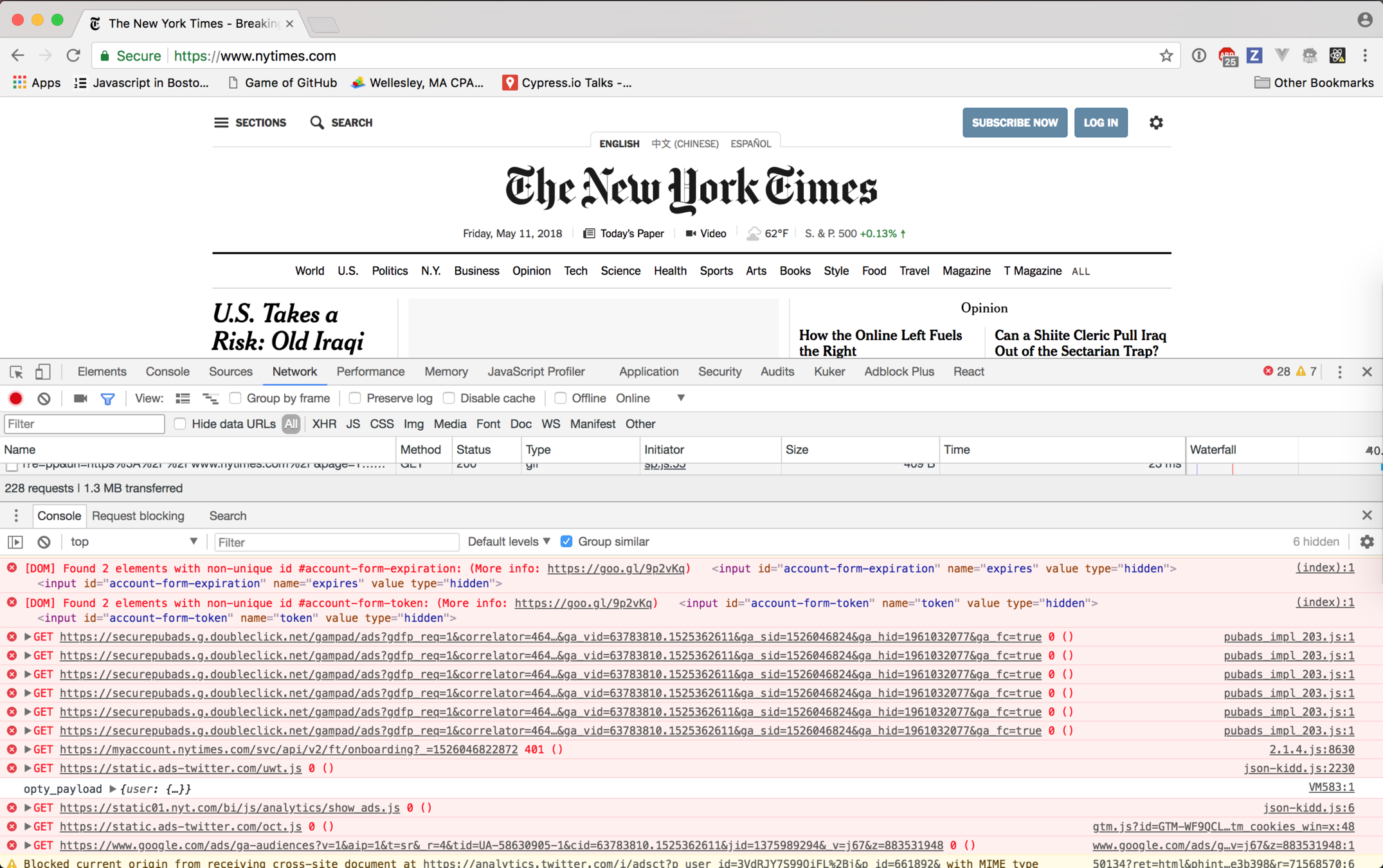
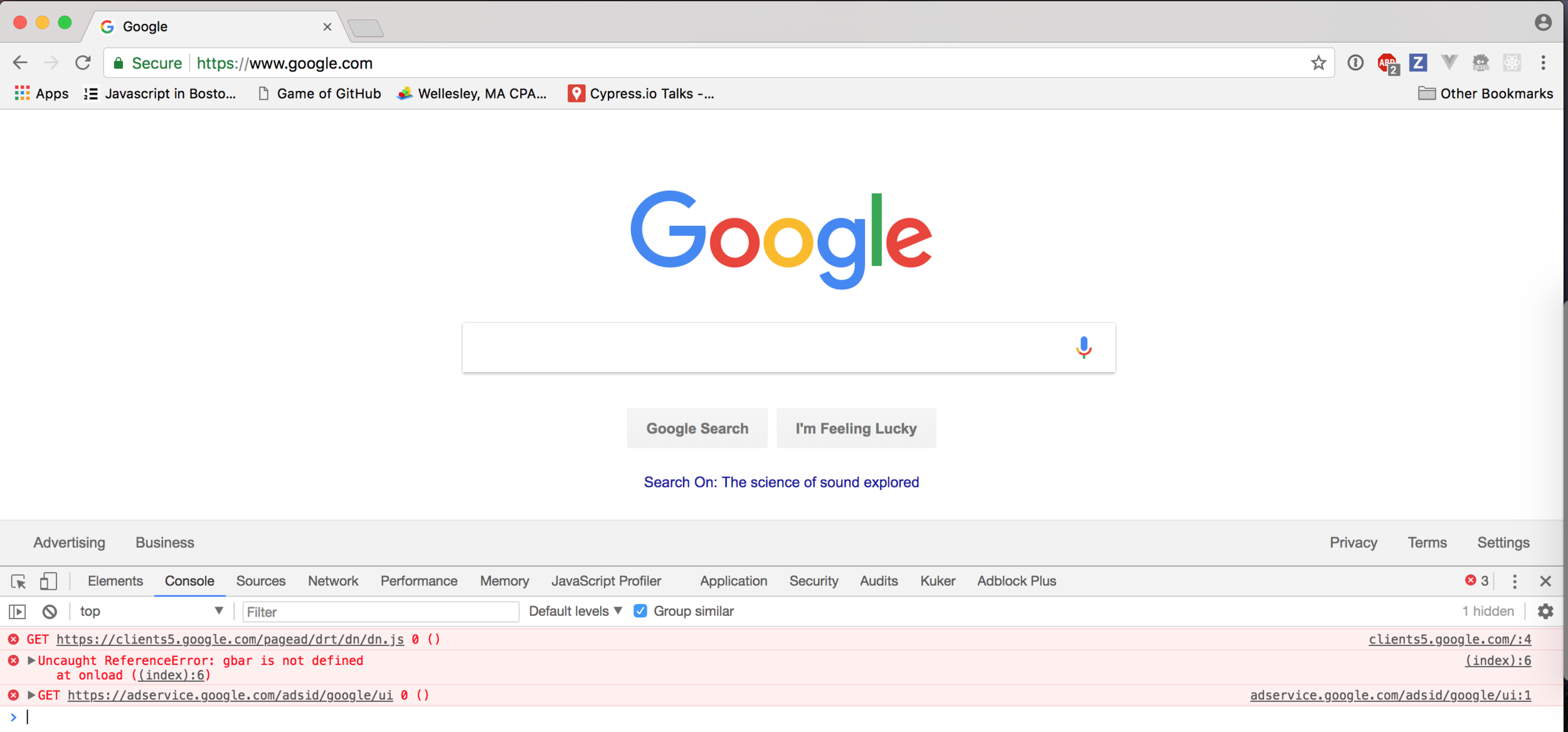
Every working website looks the same. Every broken web app is broken in its own way.
Leo Tolstoy, "Anna Karenina"
(paraphrasing)
I love good software
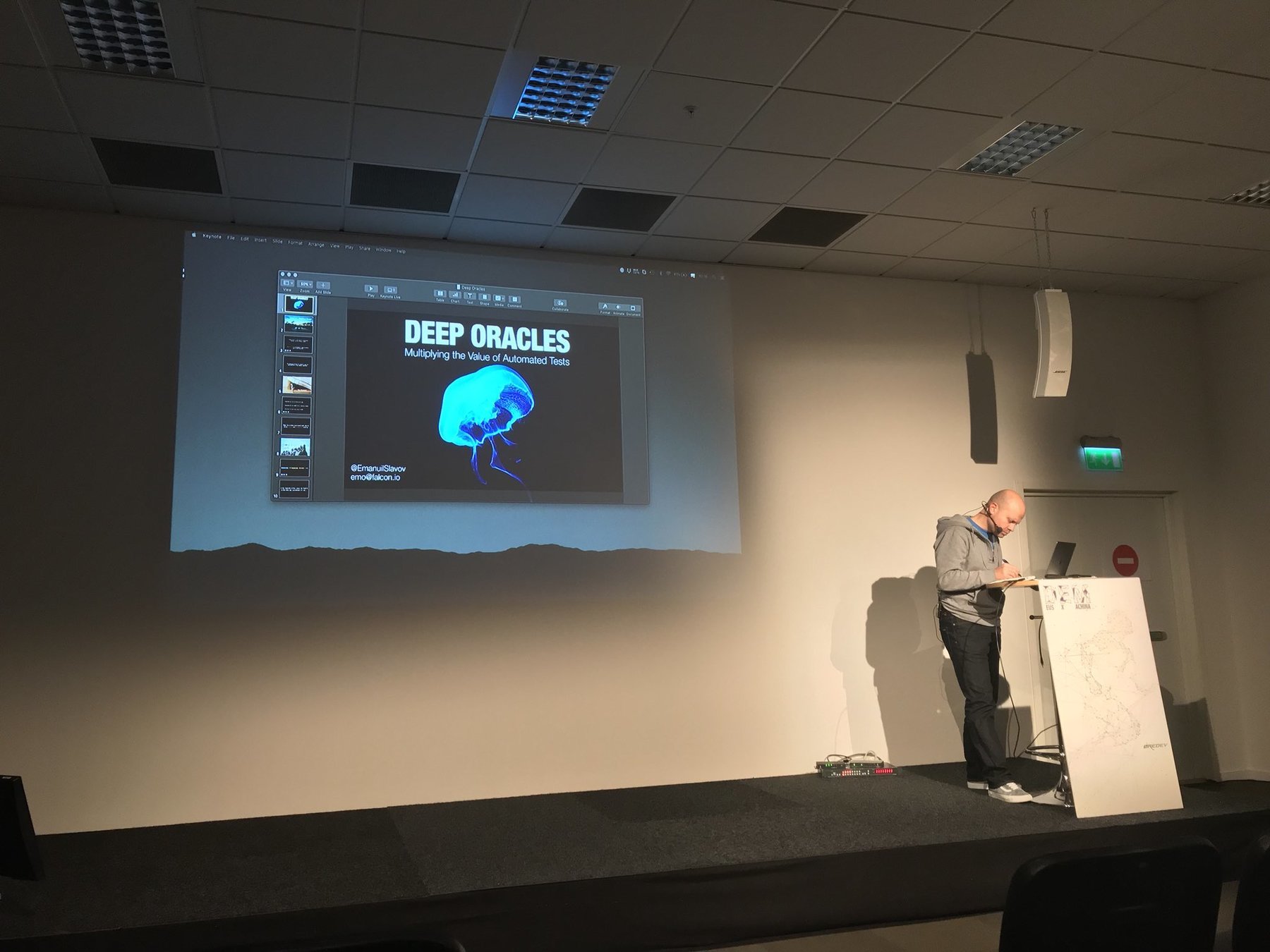
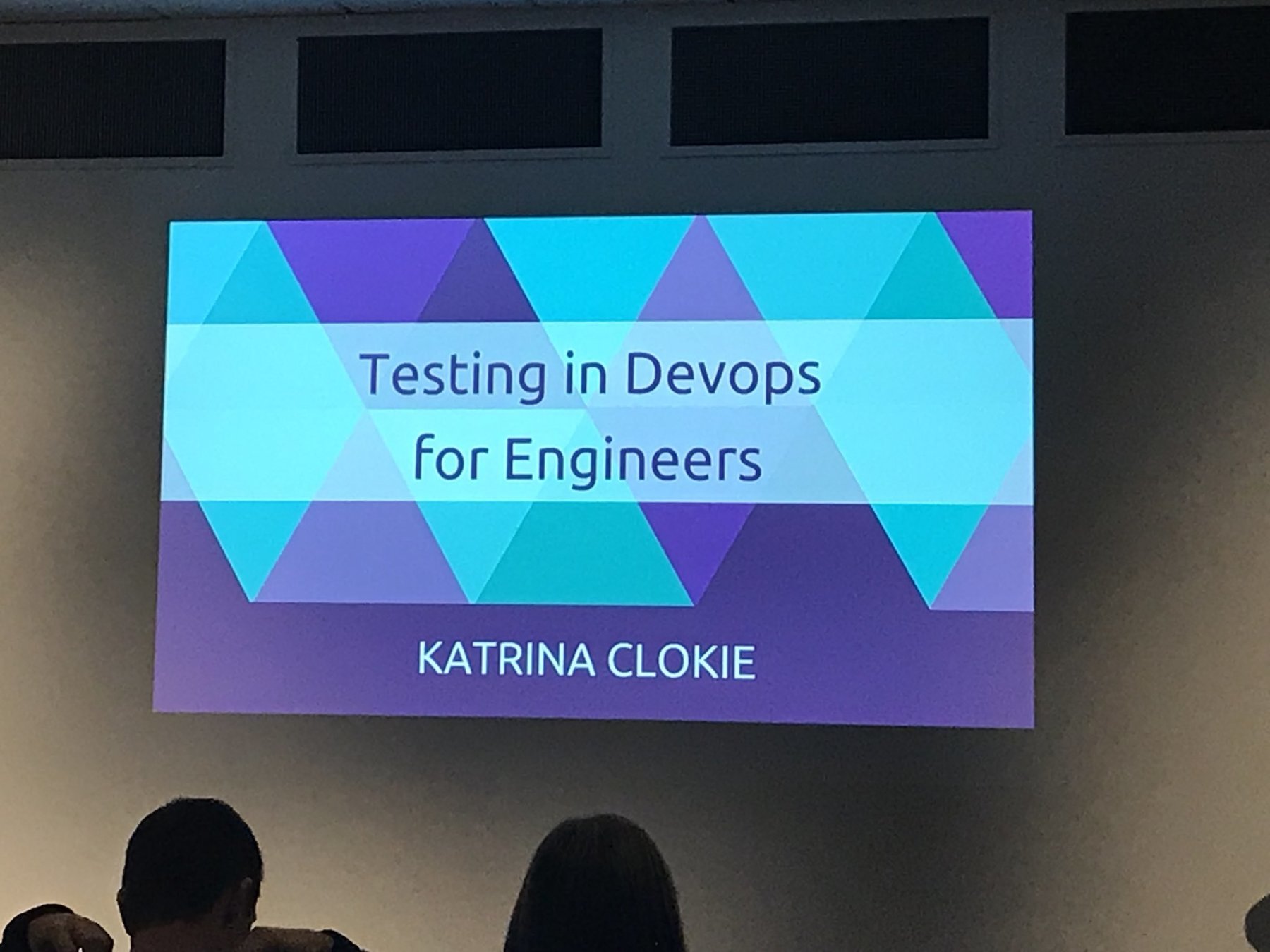
Deep Oracles
Testing in Devops for Engineers
We going to need some tests
80 blog posts
E2E
integration
unit
Smallest pieces
E2E
integration
unit

Tape, QUnit, Mocha, Ava, Jest
Delightful JavaScript Testing
$ npm install --save-dev jest
$ node_modules/.bin/jest/* eslint-env jest */
describe('add', () => {
const add = require('.').add
it('adds numbers', () => {
expect(add(1, 2)).toBe(3)
})
})Unit Tests
Short: setup and assertion
Code coverage
Focus on the code
E2E
integration
unit
Web application
- Open real browser
- Load actual app
- Interact with app like a real user
- See if it works
E2E
integration
unit
Really important to users
Really important to developers
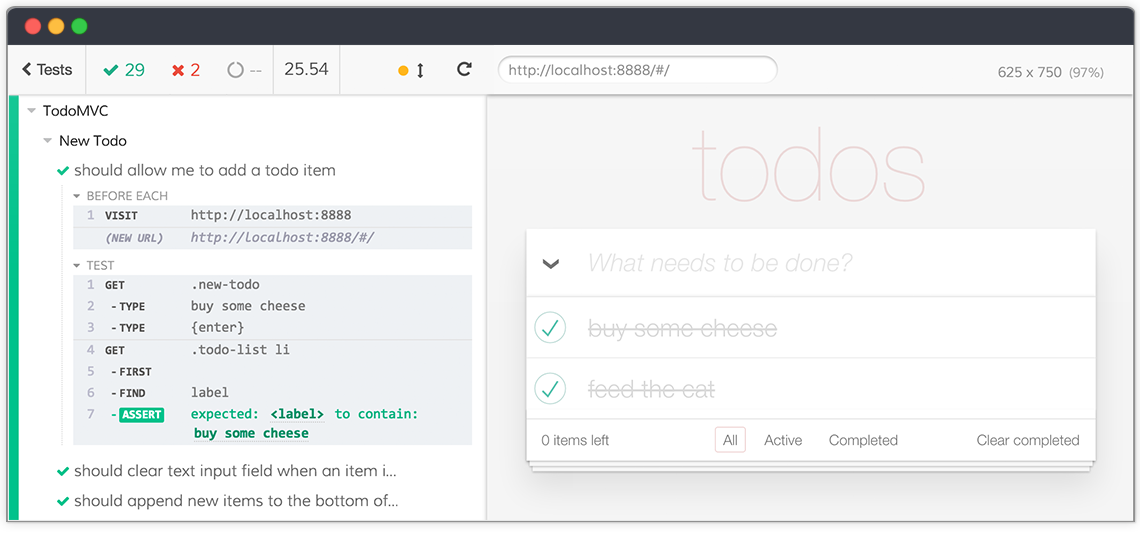
When should I write an end-to-end test?
planning
coding
deploying
staging / QA
production
E2E
E2E
Users
planning
coding
deploying
staging / QA
production
💵
E2E
E2E
Users
💵
🐞$0
💵
💵
💰
💰
💰
💰
💰
💰
💰
💰
💰
💰
💰
💰
💰
💰
💰
💰
💰
💰
💵
💵
planning
coding
deploying
staging / QA
production
💵
E2E
E2E
Users
💵
🐞$0
💵
💰
💰
💰
💰
💰
💰
💰
💰
💰
💰
💰
💰
💰
💰
💰
💰
💰
💰
Answer: E2E
💵
💵
💵
Test the software the way
the user would use it
it('changes the URL when "awesome" is clicked', () => {
cy.visit('/my/resource/path')
cy.get('.awesome-selector')
.click()
cy.url()
.should('include',
'/my/resource/path#awesomeness')
})Declarative Syntax
there are no async / awaits or promise chains
Tests should read naturally
const puppeteer = require('puppeteer');
(async () => {
const browser = await puppeteer.launch();
const page = await browser.newPage();
await page.goto('https://example.com');
await page.screenshot({path: 'example.png'});
await browser.close();
})();Puppeteer
test('My Test', async t => {
await t
.setNativeDialogHandler(() => true)
.click('#populate')
.click('#submit-button');
const location = await t.eval(() => window.location);
await t.expect(location.pathname)
.eql('/testcafe/example/thank-you.html');
});TestCafe
it('changes the URL when "awesome" is clicked', () => {
const user = cy
user.visit('/my/resource/path')
user.get('.awesome-selector')
.click()
user.url()
.should('include',
'/my/resource/path#awesomeness')
})Cypress is like a real user
Kent C Dodds https://testingjavascript.com/

Dear user,
- open url localhost:3000/my/resource/path
- click on button "foo"
- check if url includes /my/resource/path#awesomeness
more details: "End-to-end Testing Is Hard - But It Doesn't Have to Be" ReactiveConf 2018 https://www.youtube.com/watch?v=swpz0H0u13k
Unit vs E2E
unit test:
-
focus on code
-
short
-
black box
end-to-end test:
-
focus on feature
-
long
-
external effects
When should I write a unit test vs end-to-end test?
export const add = (a, b) => a + bMy code is called by
import {add} from './math'
add(2, 3)other code
export const add = (a, b) => a + bMy code is called by
import {add} from './math'
add(2, 3)other code
Unit Test
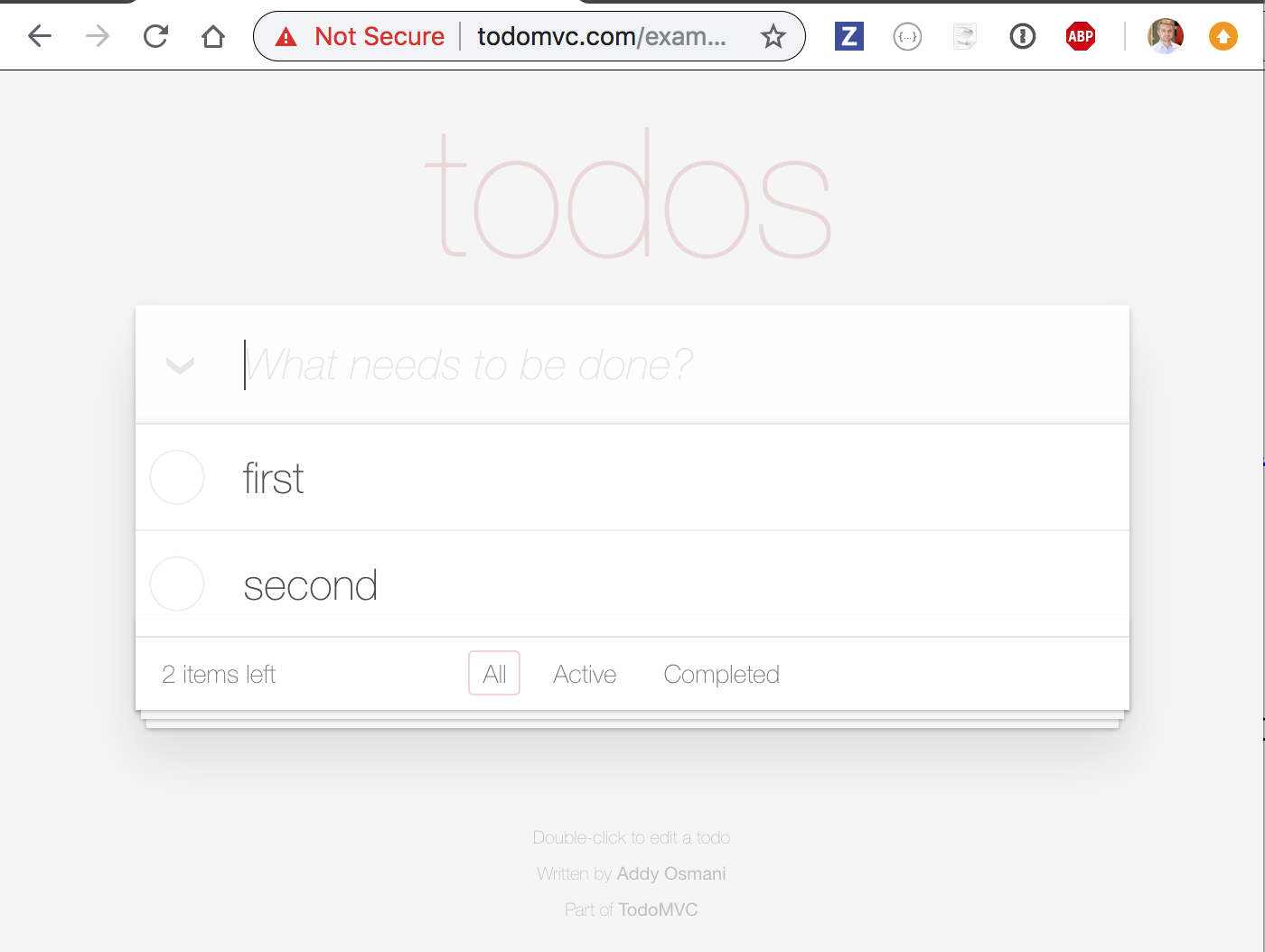
My code is called by the user

My code is called by the user
E2E Test
unit test:
-
you are mocking way too much
end-to-end test:
(enzyme, js-dom)
unit test
end-to-end test:
-
The tests does not behave like a user
unit test:
-
focus on X
-
gives you confidence
-
runs locally and on CI
end-to-end test:
-
focus on X
-
gives you confidence
-
runs locally and on CI
commonalities
Crashes will happen
image source: http://ktla.com/2016/04/02/small-plane-crashes-into-suv-on-15-freeway-in-san-diego-county/
undefined is not a function
Sentry.io crash service
if (process.env.NODE_ENV === 'production') {
var raven = require('raven');
var SENTRY_DSN = 'https://<DSN>@app.getsentry.com/...';
var client = new raven.Client(SENTRY_DSN);
client.patchGlobal();
}
foo.bar // this Error will be reportednpm install raven --save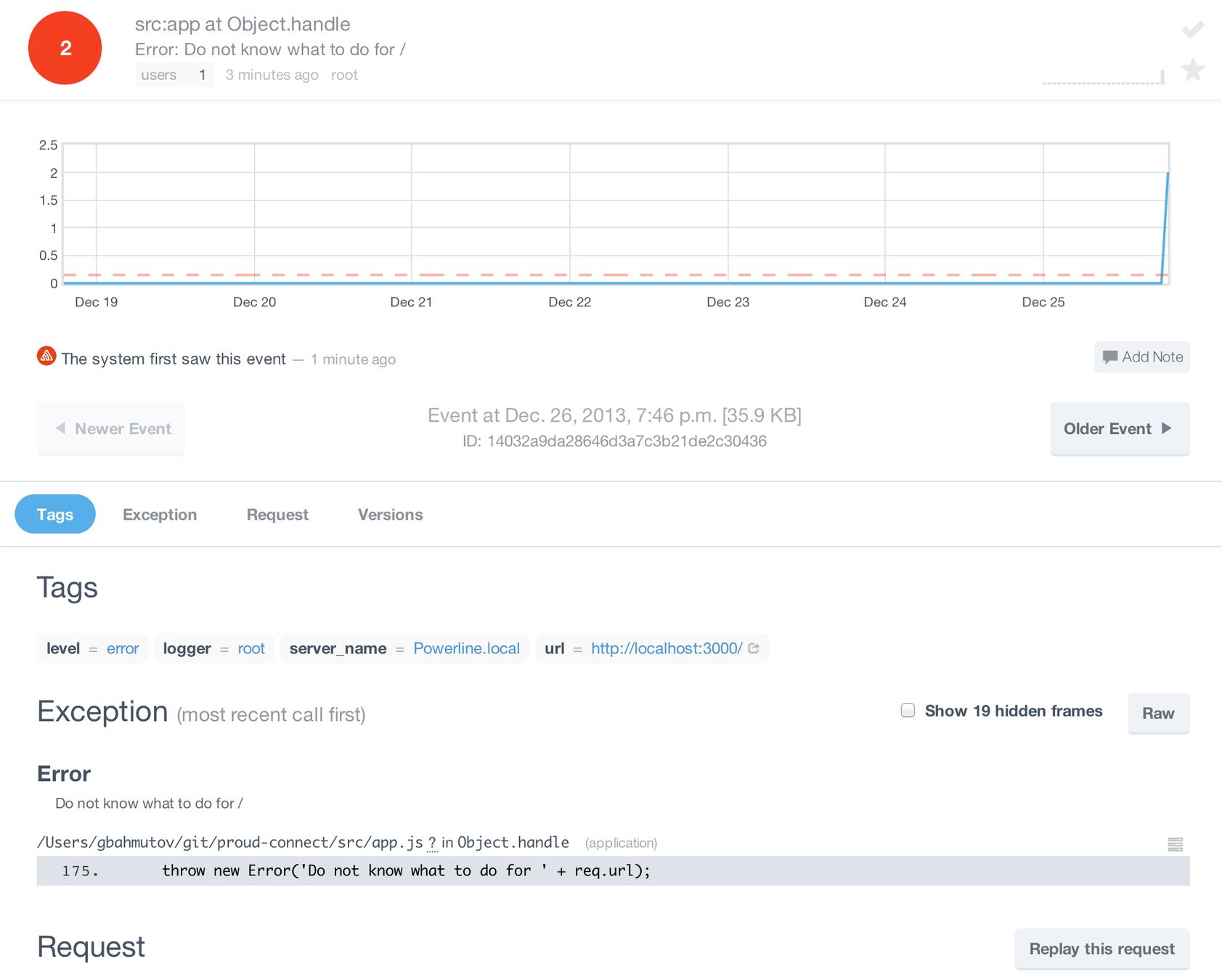

Stack traces
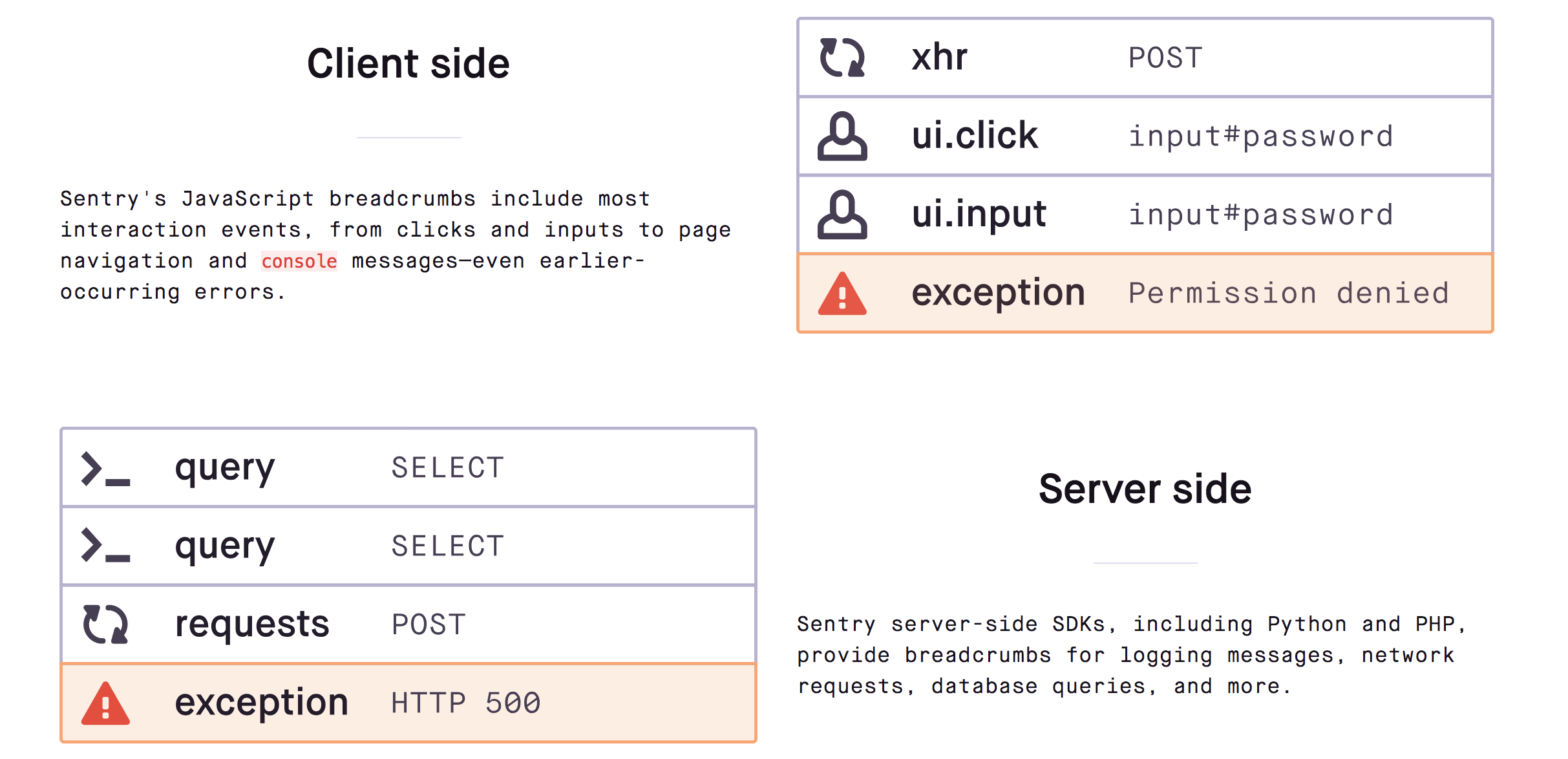
Breadcrumbs
Keep your test balance
unit / E2E tests for happy path
error handling
tests based on crashes
50%
20%
30%
Writing tests
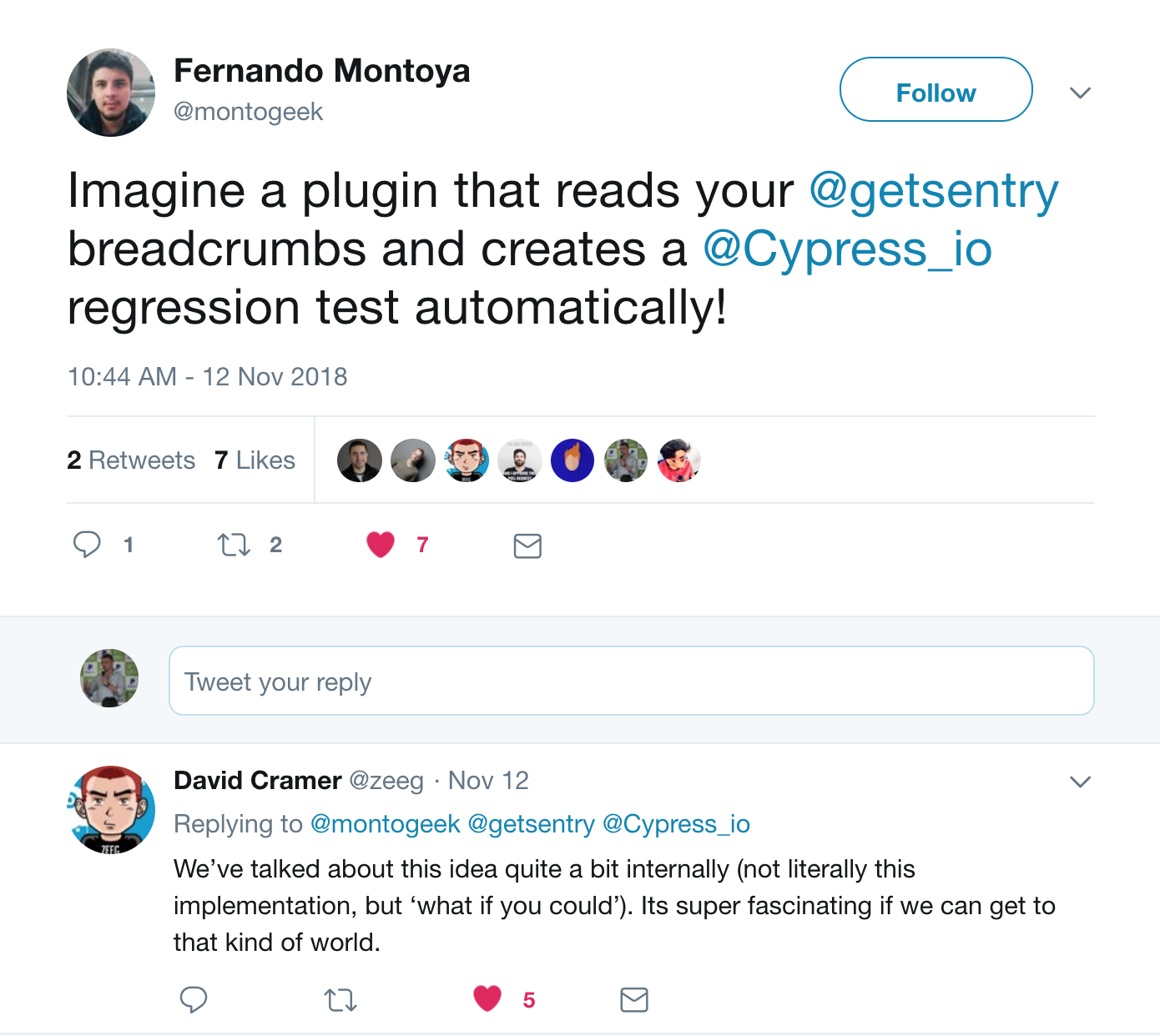
Why this does not work:
Generate test from crash breadcrumbs ...
Record user actions and generate a test...
Good GitHub issue:
What did you do?
What did you expect to happen?
What has happened?
(repeat)
it('adds 2 todos', () => {
cy.visit('http://localhost:3000')
cy.get('.new-todo')
.type('learn testing{enter}')
cy.get('.todo-list li')
.should('have.length', 1)
cy.get('.new-todo')
.type('be cool{enter}')
cy.get('.todo-list li')
.should('have.length', 2)
})command (action)
assertion
command (action)
assertion
Good Test
command (action)
assertion
command (action)
assertion
Good Test
Easy to record
user actions
command (action)
assertion
command (action)
assertion
Good Test
How to generate assertions from user recording?!
If you have ideas, let me know
@bahmutov
Good news about Continuous Integration
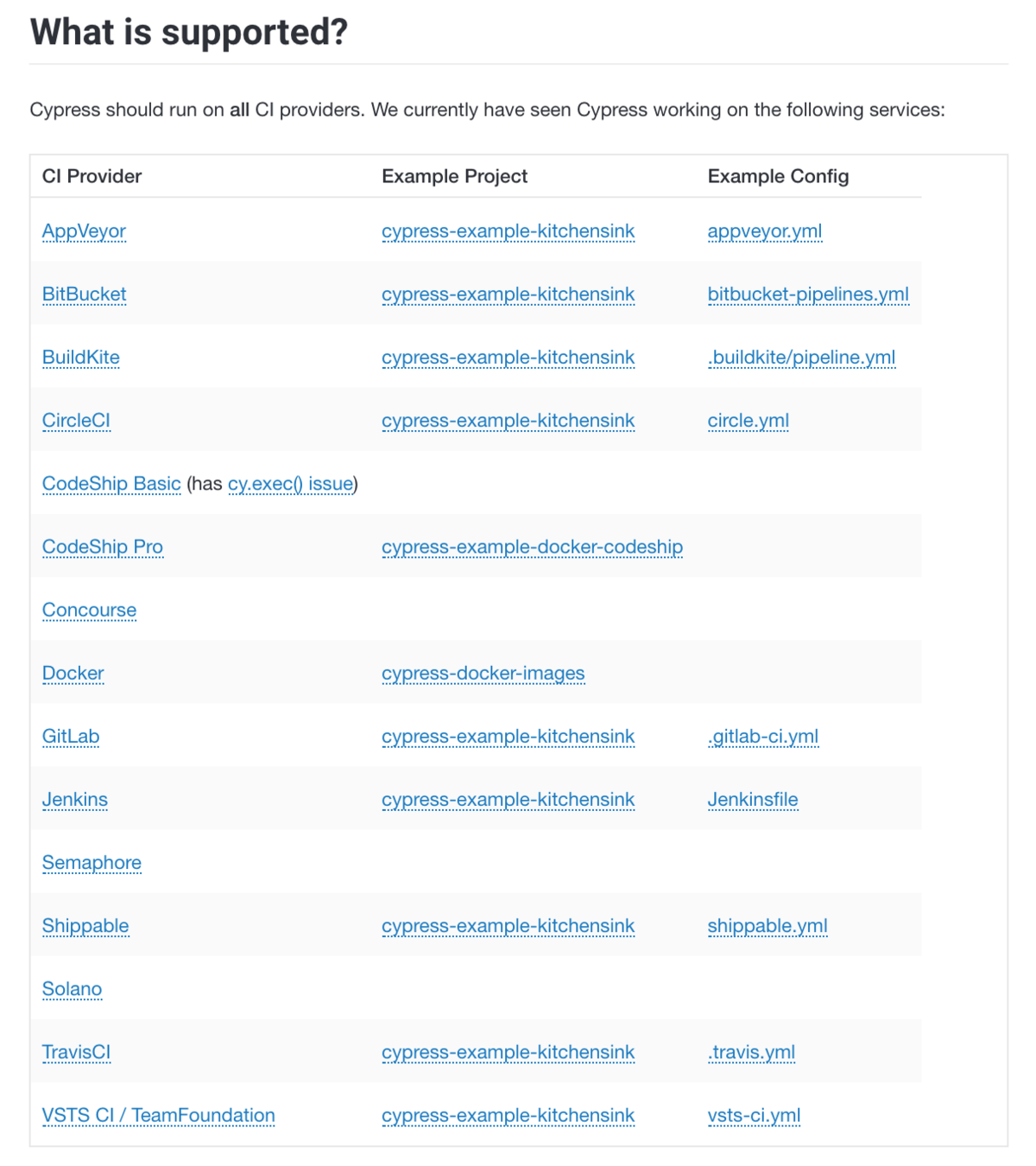
Making it easy for users is not easy
version: 2
jobs:
test:
docker:
- image: cypress/base:10
steps:
- checkout
# restore folders with npm dependencies and Cypress binary
- restore_cache:
keys:
- cache-{{ checksum "package.json" }}
# install npm dependencies and Cypress binary
# if they were cached, this step is super quick
- run:
name: Install dependencies
command: npm ci
- run: npm run cy:verify
# save npm dependencies and Cypress binary for future runs
- save_cache:
key: cache-{{ checksum "package.json" }}
paths:
- ~/.npm
- ~/.cache
# start server before starting tests
- run:
command: npm start
background: true
- run: npm run e2e:record
workflows:
version: 2
build:
jobs:
- testDocker image
typical CI config file
version: 2
jobs:
test:
docker:
- image: cypress/base:10
steps:
- checkout
# restore folders with npm dependencies and Cypress binary
- restore_cache:
keys:
- cache-{{ checksum "package.json" }}
# install npm dependencies and Cypress binary
# if they were cached, this step is super quick
- run:
name: Install dependencies
command: npm ci
- run: npm run cy:verify
# save npm dependencies and Cypress binary for future runs
- save_cache:
key: cache-{{ checksum "package.json" }}
paths:
- ~/.npm
- ~/.cache
# start server before starting tests
- run:
command: npm start
background: true
- run: npm run e2e:record
workflows:
version: 2
build:
jobs:
- testDocker image
Caching
Caching
typical CI config file
version: 2
jobs:
test:
docker:
- image: cypress/base:10
steps:
- checkout
# restore folders with npm dependencies and Cypress binary
- restore_cache:
keys:
- cache-{{ checksum "package.json" }}
# install npm dependencies and Cypress binary
# if they were cached, this step is super quick
- run:
name: Install dependencies
command: npm ci
- run: npm run cy:verify
# save npm dependencies and Cypress binary for future runs
- save_cache:
key: cache-{{ checksum "package.json" }}
paths:
- ~/.npm
- ~/.cache
# start server before starting tests
- run:
command: npm start
background: true
- run: npm run e2e:record
workflows:
version: 2
build:
jobs:
- testDocker image
Caching
Caching
Install
typical CI config file
version: 2
jobs:
test:
docker:
- image: cypress/base:10
steps:
- checkout
# restore folders with npm dependencies and Cypress binary
- restore_cache:
keys:
- cache-{{ checksum "package.json" }}
# install npm dependencies and Cypress binary
# if they were cached, this step is super quick
- run:
name: Install dependencies
command: npm ci
- run: npm run cy:verify
# save npm dependencies and Cypress binary for future runs
- save_cache:
key: cache-{{ checksum "package.json" }}
paths:
- ~/.npm
- ~/.cache
# start server before starting tests
- run:
command: npm start
background: true
- run: npm run e2e:record
workflows:
version: 2
build:
jobs:
- testDocker image
Caching
Caching
App and tests
typical CI config file
Install
defaults: &defaults
working_directory: ~/app
docker:
- image: cypress/browsers:chrome67
version: 2
jobs:
build:
<<: *defaults
steps:
- checkout
# find compatible cache from previous build,
# it should have same dependencies installed from package.json checksum
- restore_cache:
keys:
- cache-{{ .Branch }}-{{ checksum "package.json" }}
- run:
name: Install Dependencies
command: npm ci
# run verify and then save cache.
# this ensures that the Cypress verified status is cached too
- run: npm run cy:verify
# save new cache folder if needed
- save_cache:
key: cache-{{ .Branch }}-{{ checksum "package.json" }}
paths:
- ~/.npm
- ~/.cache
- run: npm run types
- run: npm run stop-only
# all other test jobs will run AFTER this build job finishes
# to avoid reinstalling dependencies, we persist the source folder "app"
# and the Cypress binary to workspace, which is the fastest way
# for Circle jobs to pass files
- persist_to_workspace:
root: ~/
paths:
- app
- .cache/Cypress
4x-electron:
<<: *defaults
# tell CircleCI to execute this job on 4 machines simultaneously
parallelism: 4
steps:
- attach_workspace:
at: ~/
- run:
command: npm start
background: true
# runs Cypress test in load balancing (parallel) mode
# and groups them in Cypress Dashboard under name "4x-electron"
- run: npm run e2e:record -- --parallel --group $CIRCLE_JOB
workflows:
version: 2
# this workflow has 4 jobs to show case Cypress --parallel and --group flags
# "build" installs NPM dependencies so other jobs don't have to
# └ "1x-electron" runs all specs just like Cypress pre-3.1.0 runs them
# └ "4x-electron" job load balances all specs across 4 CI machines
# └ "2x-chrome" load balances all specs across 2 CI machines and uses Chrome browser
build_and_test:
jobs:
- build
# this group "4x-electron" will load balance all specs
# across 4 CI machines
- 4x-electron:
requires:
- buildParallel config is ... more complicated
typical CI config file
# first, install Cypress, then run all tests (in parallel)
stages:
- build
- test
# to cache both npm modules and Cypress binary we use environment variables
# to point at the folders we can list as paths in "cache" job settings
variables:
npm_config_cache: "$CI_PROJECT_DIR/.npm"
CYPRESS_CACHE_FOLDER: "$CI_PROJECT_DIR/cache/Cypress"
# cache using branch name
# https://gitlab.com/help/ci/caching/index.md
cache:
key: ${CI_COMMIT_REF_SLUG}
paths:
- .npm
- cache/Cypress
- node_modules
# this job installs NPM dependencies and Cypress
install:
image: cypress/base:10
stage: build
script:
- npm ci
- $(npm bin)/print-env CI
- npm run cy:verify
# all jobs that actually run tests can use the same definition
.job_template: &job
image: cypress/base:10
stage: test
script:
# print CI environment variables for reference
- $(npm bin)/print-env CI
# start the server in the background
- npm run start:ci &
# run Cypress test in load balancing mode, pass id to tie jobs together
- npm run e2e:record -- --parallel --ci-build-id $CI_PIPELINE_ID --group electrons
# actual job definitions
# all steps are the same, they come from the template above
electrons-1:
<<: *job
electrons-2:
<<: *job
electrons-3:
<<: *job
electrons-4:
<<: *job
electrons-5:
<<: *jobpipeline {
agent {
// this image provides everything needed to run Cypress
docker {
image 'cypress/base:10'
}
}
stages {
// first stage installs node dependencies and Cypress binary
stage('build') {
steps {
// there a few default environment variables on Jenkins
// on local Jenkins machine (assuming port 8080) see
// http://localhost:8080/pipeline-syntax/globals#env
echo "Running build ${env.BUILD_ID} on ${env.JENKINS_URL}"
sh 'npm ci'
sh 'npm run cy:verify'
}
}
stage('start local server') {
steps {
// start local server in the background
// we will shut it down in "post" command block
sh 'nohup npm start &'
}
}
// this tage runs end-to-end tests, and each agent uses the workspace
// from the previous stage
stage('cypress parallel tests') {
environment {
// we will be recordint test results and video on Cypress dashboard
// to record we need to set an environment variable
// we can load the record key variable from credentials store
// see https://jenkins.io/doc/book/using/using-credentials/
CYPRESS_RECORD_KEY = credentials('cypress-example-kitchensink-record-key')
// because parallel steps share the workspace they might race to delete
// screenshots and videos folders. Tell Cypress not to delete these folders
CYPRESS_trashAssetsBeforeRuns = 'false'
}
// https://jenkins.io/doc/book/pipeline/syntax/#parallel
parallel {
// start several test jobs in parallel, and they all
// will use Cypress Dashboard to load balance any found spec files
stage('tester A') {
steps {
echo "Running build ${env.BUILD_ID}"
sh "npm run e2e:record:parallel"
}
}
// second tester runs the same command
stage('tester B') {
steps {
echo "Running build ${env.BUILD_ID}"
sh "npm run e2e:record:parallel"
}
}
}
}
}
post {
// shutdown the server running in the background
always {
echo 'Stopping local server'
sh 'pkill -f http-server'
}
}
}language: node_js
node_js:
# Node 10.3+ includes npm@6 which has good "npm ci" command
- 10.8
cache:
# cache both npm modules and Cypress binary
directories:
- ~/.npm
- ~/.cache
override:
- npm ci
- npm run cy:verify
defaults: &defaults
script:
# ## print all Travis environment variables for debugging
- $(npm bin)/print-env TRAVIS
- npm start -- --silent &
- npm run cy:run -- --record --parallel --group $STAGE_NAME
# after all tests finish running we need
# to kill all background jobs (like "npm start &")
- kill $(jobs -p) || true
jobs:
include:
# we have multiple jobs to execute using just a single stage
# but we can pass group name via environment variable to Cypress test runner
- stage: test
env:
- STAGE_NAME=1x-electron
<<: *defaults
# run tests in parallel by including several test jobs with same name variable
- stage: test
env:
- STAGE_NAME=4x-electron
<<: *defaults
- stage: test
env:
- STAGE_NAME=4x-electron
<<: *defaults
- stage: test
env:
- STAGE_NAME=4x-electron
<<: *defaults
- stage: test
env:
- STAGE_NAME=4x-electron
<<: *defaultsDifferent CIs
Copy / paste / tweak until CI passes
CircleCI Orbs
Reusable CI configuration code
CircleCI Orbs
version: 2.1
orbs:
cypress: cypress-io/cypress@1.0.0
workflows:
build:
jobs:
- cypress/runCircleCI Orbs
version: 2.1
orbs:
cypress: cypress-io/cypress@1.0.0
workflows:
build:
jobs:
- cypress/runVersioned namespaced package
CircleCI Orbs
version: 2.1
orbs:
cypress: cypress-io/cypress@1.0.0
workflows:
build:
jobs:
- cypress/run"run" command defined in cypress orb
CircleCI Orbs
version: 2.1
orbs:
cypress: cypress-io/cypress@1.0.0
workflows:
build:
jobs:
- cypress/install
- cypress/run:
requires:
- cypress/install
record: true
parallel: true
parallelism: 10
start: 'npm start'Parallel run scenario
CircleCI Orbs
version: 2.1
orbs:
cypress: cypress-io/cypress@1.0.0
workflows:
build:
jobs:
- cypress/install
- cypress/run:
requires:
- cypress/install
record: true
parallel: true
parallelism: 10
start: 'npm start'Job parameters
Orbs: best thing in CI since Docker
100% code coverage
Tools: Istanbul, NYC
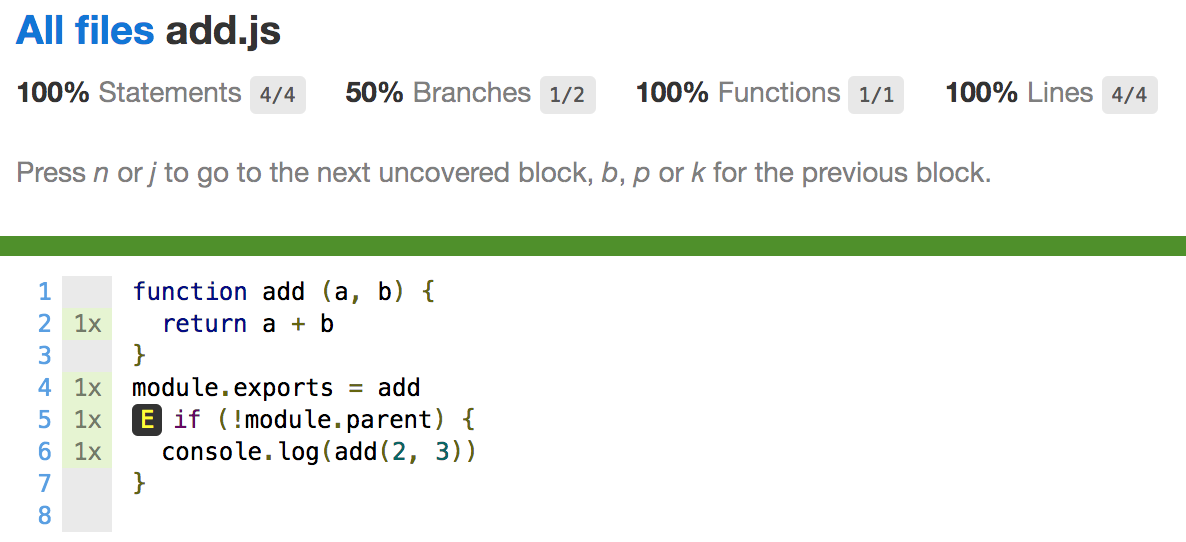

Coverage is hard
Code coverage
is tricky
const isEmail = (s) =>
/^\w+@\w+\.\w{3,4}$/.test(s)
// 1 test = 100% code coverage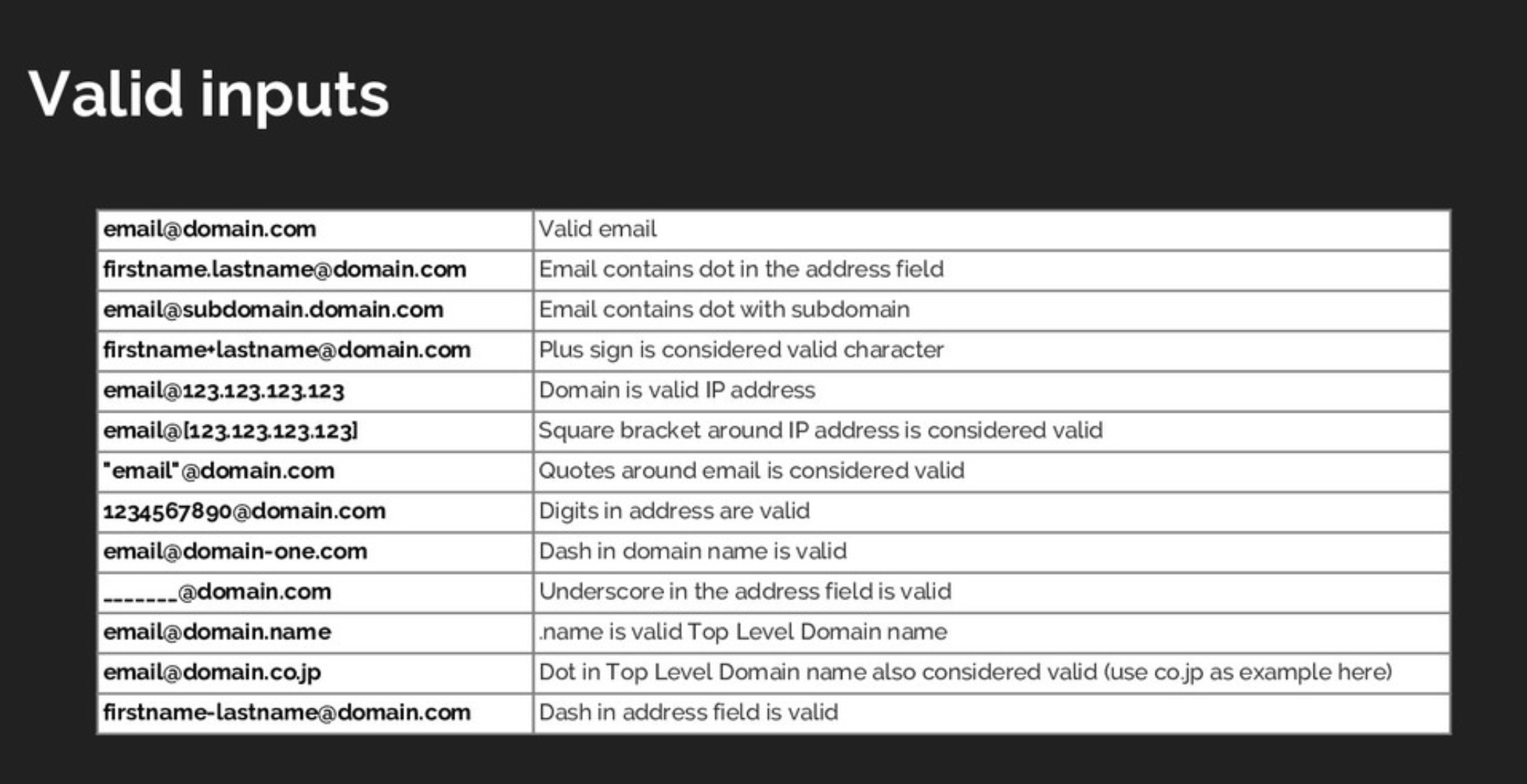
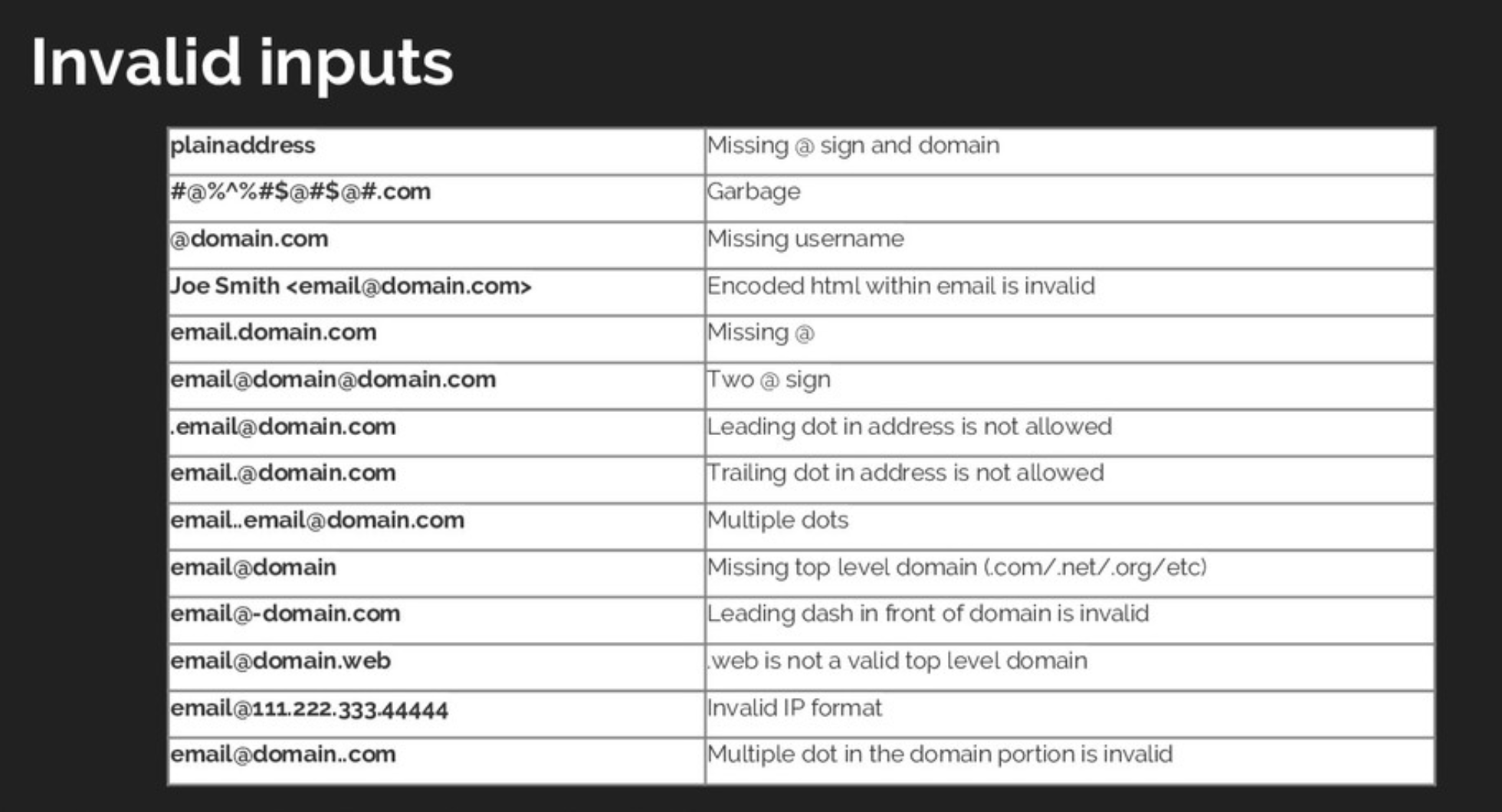
(?:[a-z0-9!#$%&'*+/=?^_`{|}~-]+(?:\.[a-z0-9!#$%&'*+/=?^_`{|}~-]+)*|"(?:[\x01-\x08\x0b\x0c\x0e-\x1f\x21\x23-\x5b\x5d-\x7f]|\\[\x01-\x09\x0b\x0c\x0e-\x7f])*")@(?:(?:[a-z0-9](?:[a-z0-9-]*[a-z0-9])?\.)+[a-z0-9](?:[a-z0-9-]*[a-z0-9])?|\[(?:(?:25[0-5]|2[0-4][0-9]|[01]?[0-9][0-9]?)\.){3}(?:25[0-5]|2[0-4][0-9]|[01]?[0-9][0-9]?|[a-z0-9-]*[a-z0-9]:(?:[\x01-\x08\x0b\x0c\x0e-\x1f\x21-\x5a\x53-\x7f]|\\[\x01-\x09\x0b\x0c\x0e-\x7f])+)\])
Code coverage
vs
Data coverage
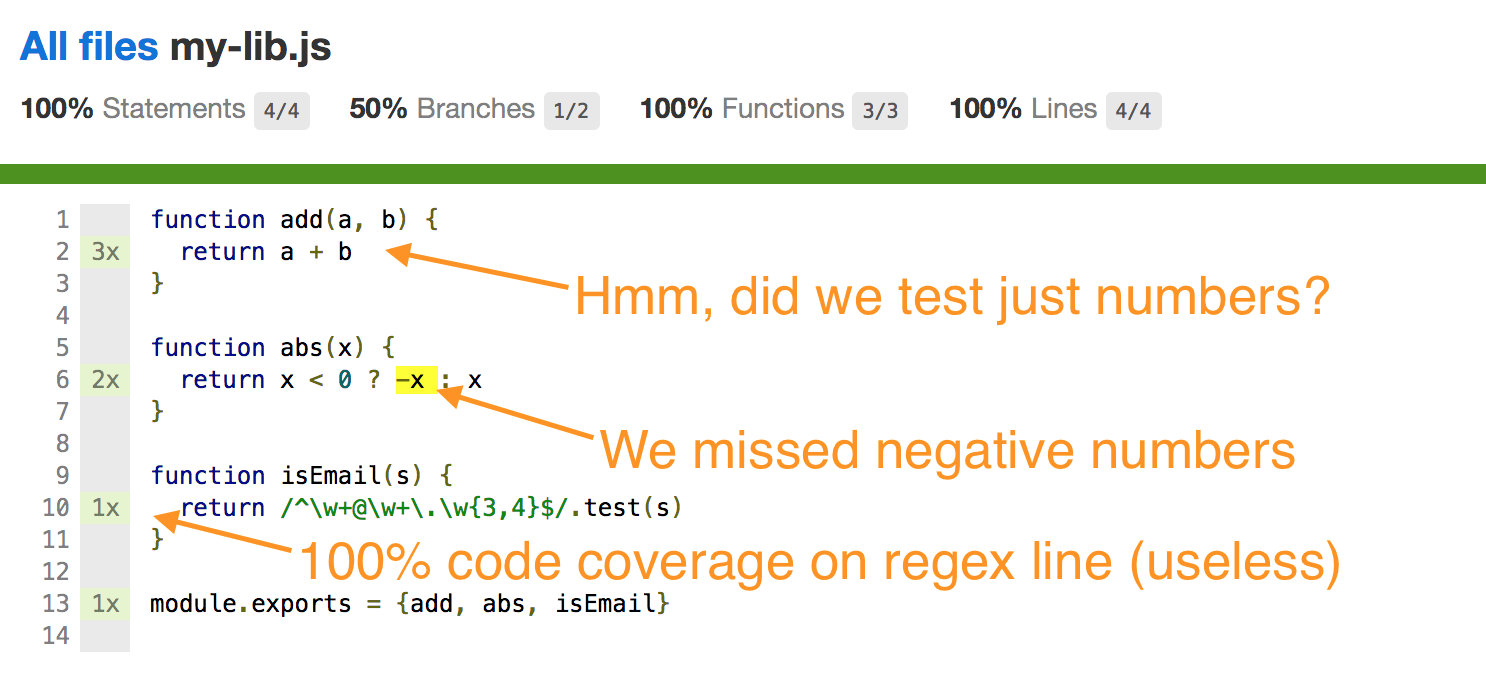
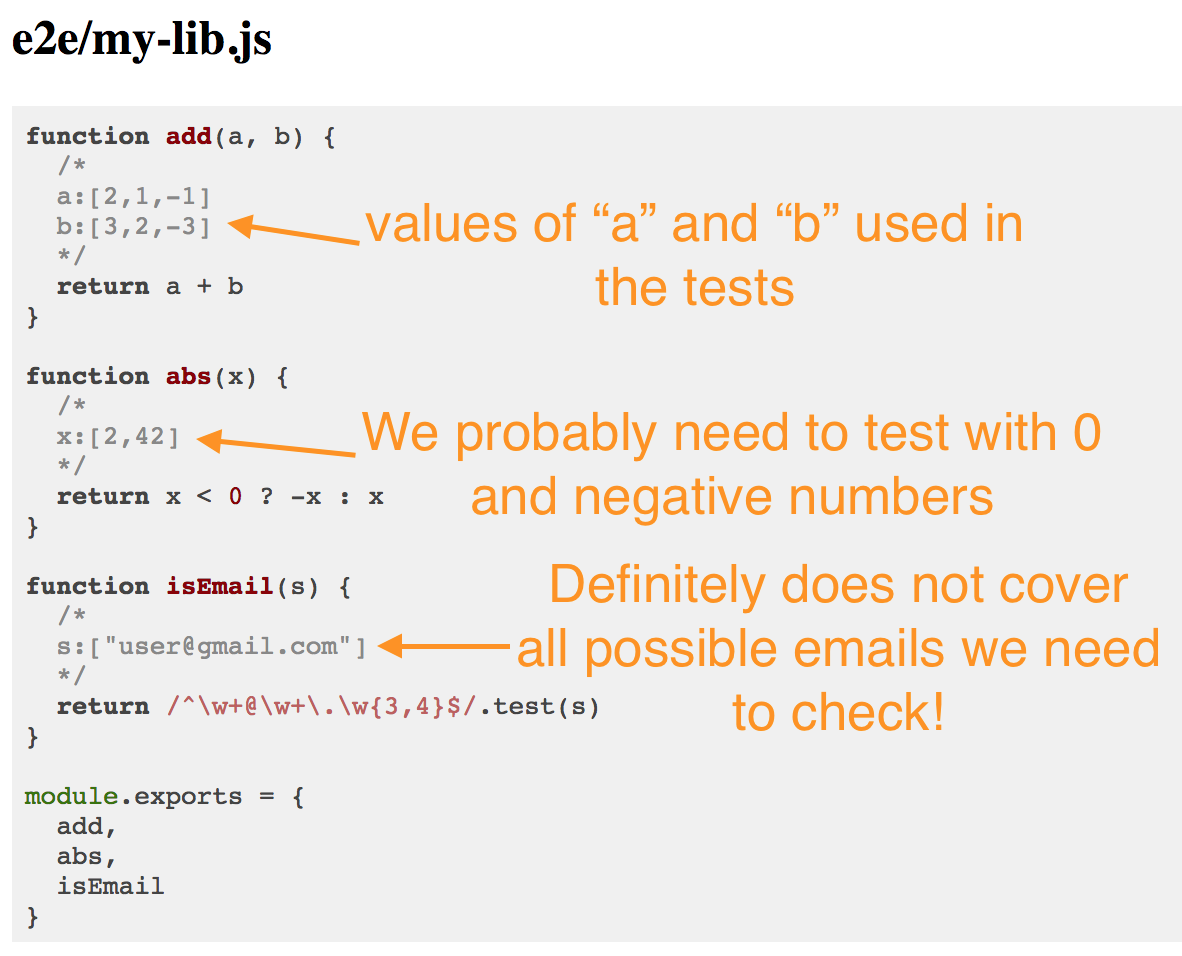
mocha -r data-cover spec.jsI don't think code coverage is useful for end-to-end tests
You cannot test every part of your car by driving around
user interface
application code
vendor code
polyfills
there is probably a lot of app code unreachable through the UI alone
beforeEach(() => {
cy.visit('/')
})
it('works', function () {
cy.get('.new-todo').type('first todo{enter}')
cy.get('.new-todo').type('second todo{enter}')
cy.get('.todo-list li').should('have.length', 2)
})What does this test cover?
Cypress.Commands.overwrite('type',
(type, $el, text, options) => {
rememberSelector($el)
return type($el, text, options)
})Track "cy.type" elements
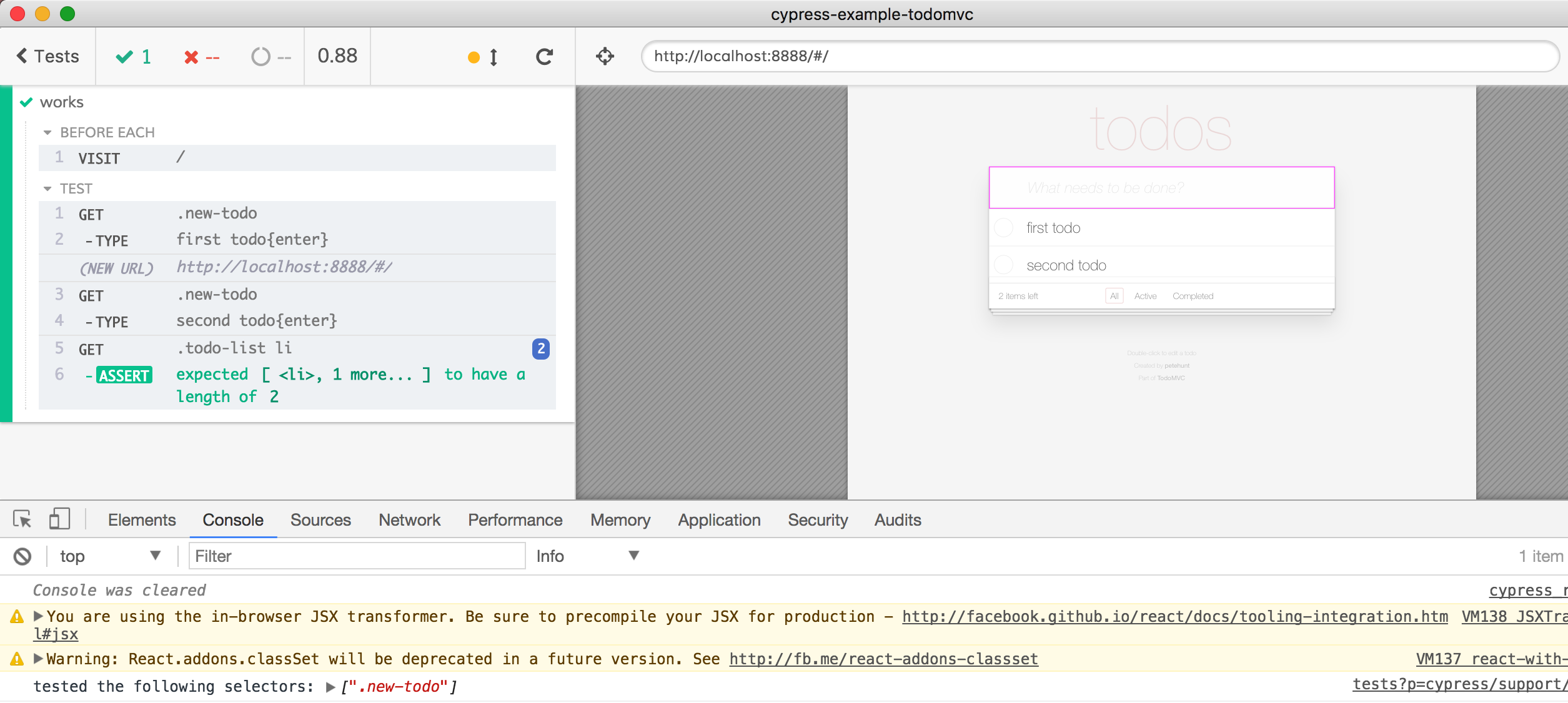
Highlight tested element

Elements NOT covered by the test
beforeEach(() => {
cy.visit('/')
})
it('works', function () {
cy.get('.new-todo').type('first todo{enter}')
cy.get('.new-todo').type('second todo{enter}')
cy.get('.todo-list li').should('have.length', 2)
.first().find(':checkbox').check()
cy.contains('.filters a', 'Active').click()
cy.url().should('include', 'active')
cy.contains('.filters a', 'Completed').click()
cy.url().should('include', 'completed')
cy.contains('.filters a', 'All').click()
cy.url().should('include', '#/')
})Extend test to cover more elements
The test did not cover "Clear completed" button
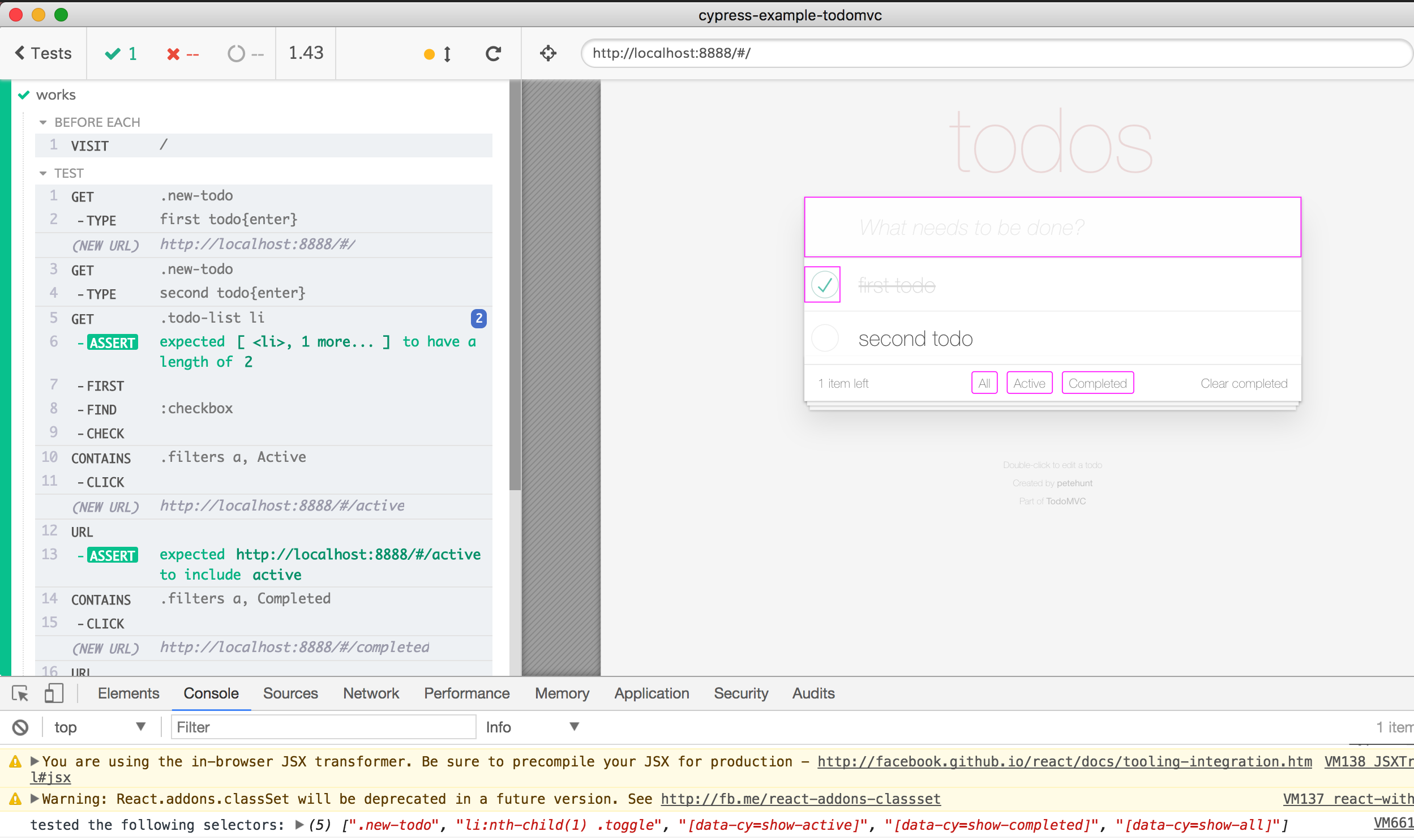
Problem: only "check" this box,
but not "uncheck"
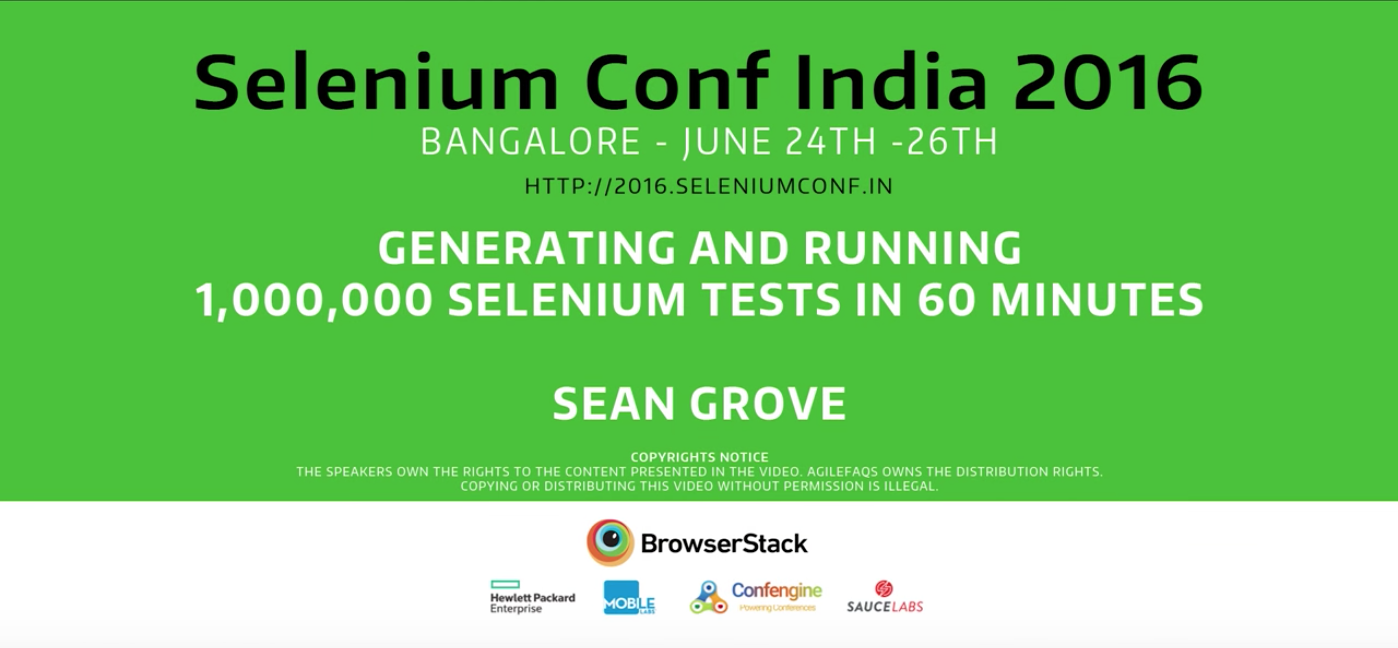
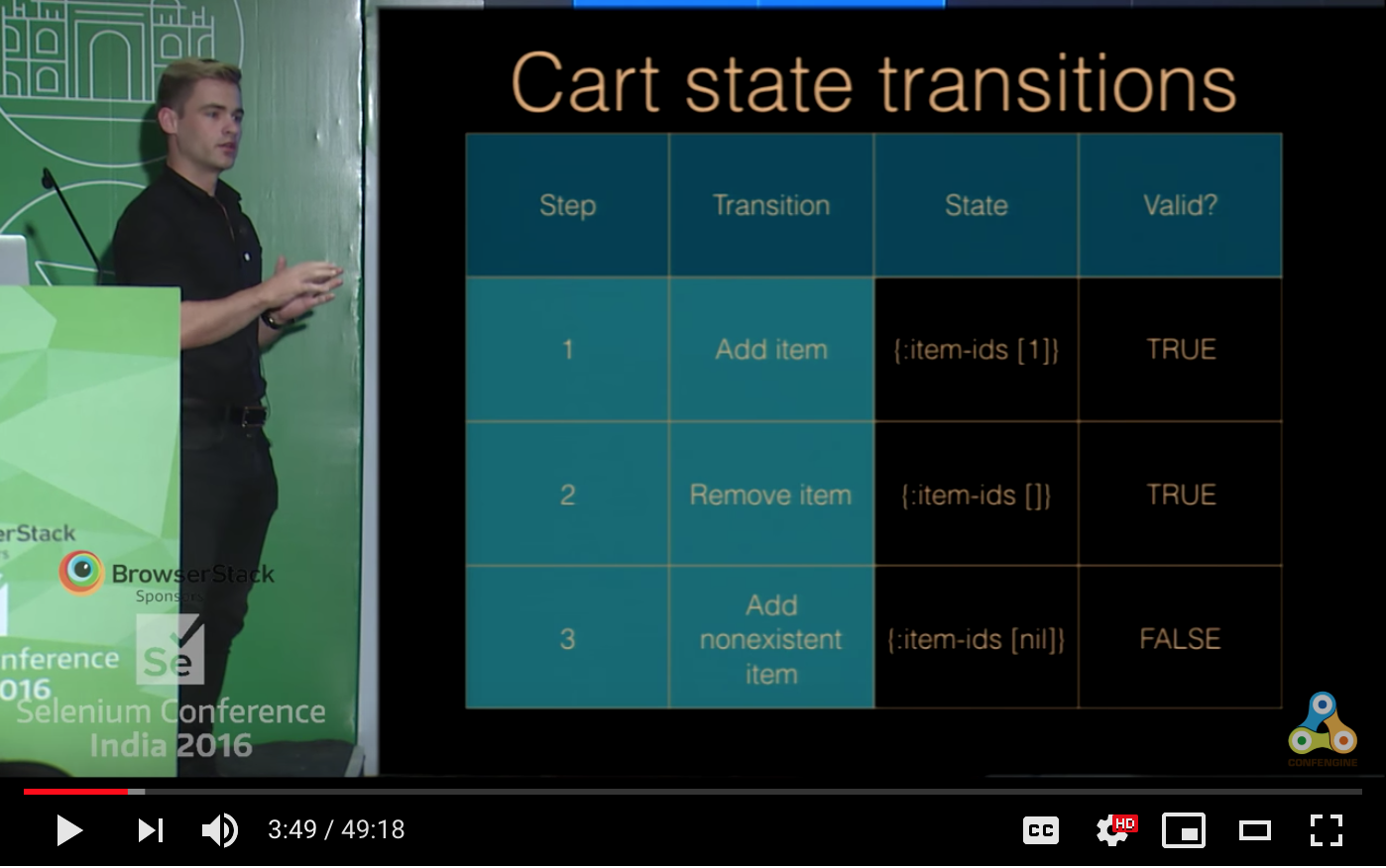
Sean Grove @sgrove
Tests should cover all important states of the app, not UI
UI = f (state)
tests = g (UI)
tests = h (state)
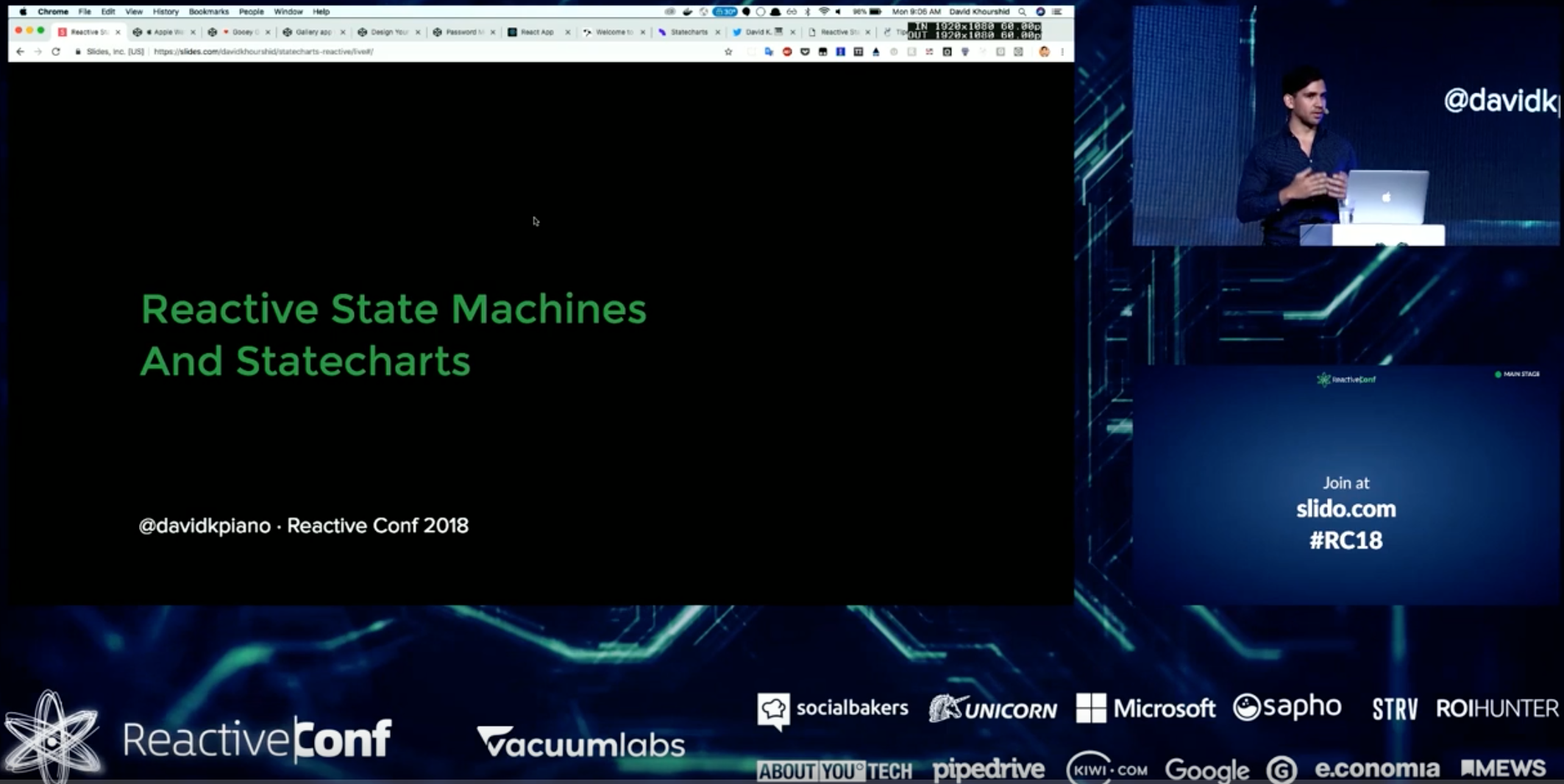
ReactiveConf 2018 – David Khourshid: Reactive State Machines and Statecharts
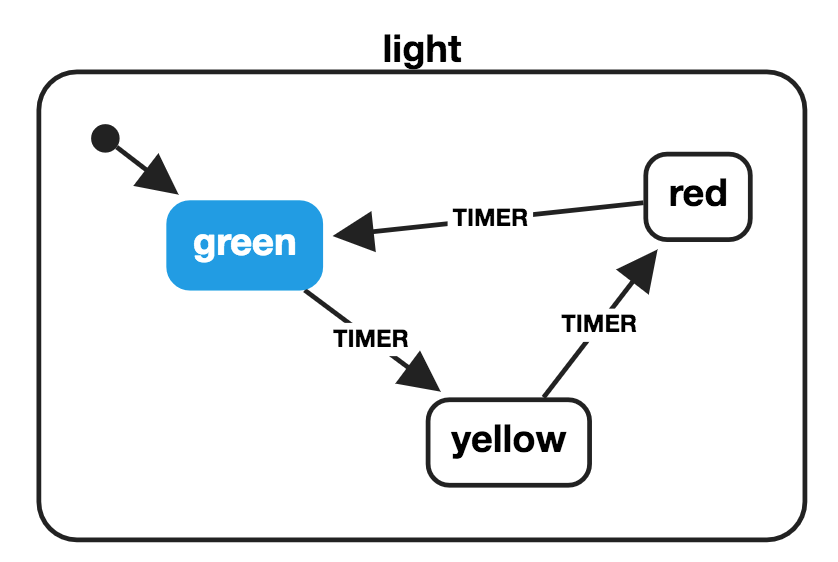
import { Machine } from 'xstate';
const lightMachine = Machine({
id: 'light',
initial: 'green',
states: {
green: {
on: {
TIMER: 'yellow',
}
},
yellow: {
on: {
TIMER: 'red',
}
},
red: {
on: {
TIMER: 'green',
}
}
}
});Code in https://github.com/bahmutov/tic-tac-toe by David K
const ticTacToeMachine = Machine(
{
initial: "playing",
states: {
playing: {
on: {
"": [
{ target: "winner", cond: "checkWin" },
{ target: "draw", cond: "checkDraw" }
],
PLAY: [
{
target: "playing",
cond: "isValidMove",
actions: "updateBoard"
}
]
}
},
winner: {
onEntry: "setWinner"
},
draw: {
type: "final"
}
}
}
...
}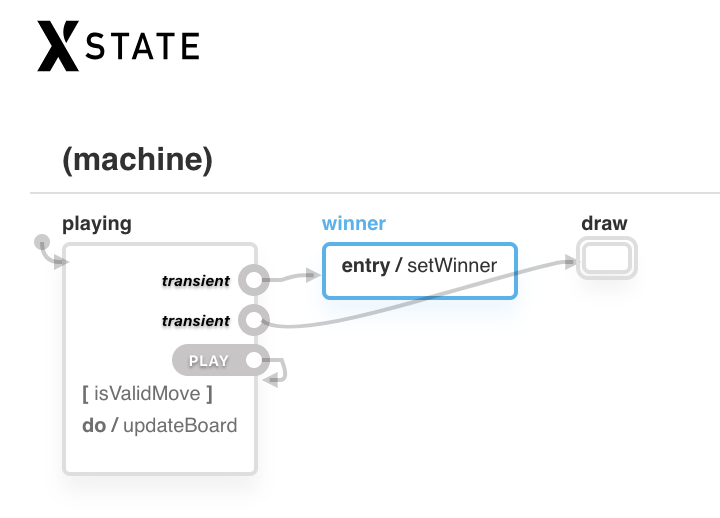
const {
getShortestValuePaths
} = require('xstate/lib/graph')
const ticTacToeMachine = require('./machine')
const shortestValuePaths = getShortestValuePaths(ticTacToeMachine)
const winnerXPath = filterWinnerX(shortestValuePaths)
const winnerOPath = filterWinnerY(shortestValuePaths)
const draws = filterDraw(shortestValuePaths)tests = h (state)
it('player X wins', () => {
play(winnerXPath)
cy.contains('h2', 'Player X wins!')
})
it('player O wins', () => {
play(winnerOPath)
cy.contains('h2', 'Player O wins!')
})
draws.forEach((draw, k) => {
it(`plays to a draw ${k}`, () => {
const drawPath = shortestValuePaths[draw]
play(drawPath)
cy.contains('h2', 'Draw')
})
})tests = h (state)
Cypress running autogenerated tests
tests
code
coverage
data
coverage
element
coverage
state
coverage
Well Tested Software
Rethink test coverage
CI configuration: orbs
If it hurts, do more of it
push ups, public speaking, code deploys, end-to-end tests
Well Tested Software
